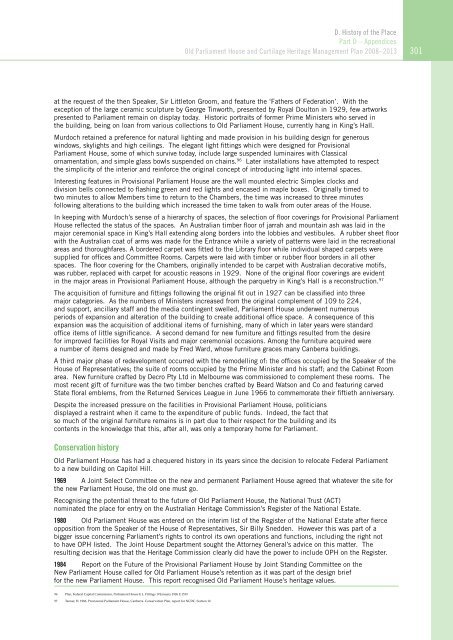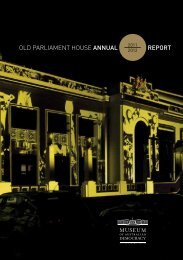OLD PARLIAMENT HOUSE AND CURTILAGE HERITAGE MANAGEMENT PLAN 2008–2013
Heritage Management Plan 2008-2013 - Museum of Australian ...
Heritage Management Plan 2008-2013 - Museum of Australian ...
- No tags were found...
Create successful ePaper yourself
Turn your PDF publications into a flip-book with our unique Google optimized e-Paper software.
D. History of the Place<br />
Part D – Appendices<br />
Old Parliament House and Curtilage Heritage Management Plan <strong>2008–2013</strong><br />
301<br />
at the request of the then Speaker, Sir Littleton Groom, and feature the ‘Fathers of Federation’. With the<br />
exception of the large ceramic sculpture by George Tinworth, presented by Royal Doulton in 1929, few artworks<br />
presented to Parliament remain on display today. Historic portraits of former Prime Ministers who served in<br />
the building, being on loan from various collections to Old Parliament House, currently hang in King’s Hall.<br />
Murdoch retained a preference for natural lighting and made provision in his building design for generous<br />
windows, skylights and high ceilings. The elegant light fittings which were designed for Provisional<br />
Parliament House, some of which survive today, include large suspended luminaires with Classical<br />
ornamentation, and simple glass bowls suspended on chains. 96 Later installations have attempted to respect<br />
the simplicity of the interior and reinforce the original concept of introducing light into internal spaces.<br />
Interesting features in Provisional Parliament House are the wall mounted electric Simplex clocks and<br />
division bells connected to flashing green and red lights and encased in maple boxes. Originally timed to<br />
two minutes to allow Members time to return to the Chambers, the time was increased to three minutes<br />
following alterations to the building which increased the time taken to walk from outer areas of the House.<br />
In keeping with Murdoch’s sense of a hierarchy of spaces, the selection of floor coverings for Provisional Parliament<br />
House reflected the status of the spaces. An Australian timber floor of jarrah and mountain ash was laid in the<br />
major ceremonial space in King’s Hall extending along borders into the lobbies and vestibules. A rubber sheet floor<br />
with the Australian coat of arms was made for the Entrance while a variety of patterns were laid in the recreational<br />
areas and thoroughfares. A bordered carpet was fitted to the Library floor while individual shaped carpets were<br />
supplied for offices and Committee Rooms. Carpets were laid with timber or rubber floor borders in all other<br />
spaces. The floor covering for the Chambers, originally intended to be carpet with Australian decorative motifs,<br />
was rubber, replaced with carpet for acoustic reasons in 1929. None of the original floor coverings are evident<br />
in the major areas in Provisional Parliament House, although the parquetry in King’s Hall is a reconstruction. 97<br />
The acquisition of furniture and fittings following the original fit out in 1927 can be classified into three<br />
major categories. As the numbers of Ministers increased from the original complement of 109 to 224,<br />
and support, ancillary staff and the media contingent swelled, Parliament House underwent numerous<br />
periods of expansion and alteration of the building to create additional office space. A consequence of this<br />
expansion was the acquisition of additional items of furnishing, many of which in later years were standard<br />
office items of little significance. A second demand for new furniture and fittings resulted from the desire<br />
for improved facilities for Royal Visits and major ceremonial occasions. Among the furniture acquired were<br />
a number of items designed and made by Fred Ward, whose furniture graces many Canberra buildings.<br />
A third major phase of redevelopment occurred with the remodelling of: the offices occupied by the Speaker of the<br />
House of Representatives; the suite of rooms occupied by the Prime Minister and his staff; and the Cabinet Room<br />
area. New furniture crafted by Decro Pty Ltd in Melbourne was commissioned to complement these rooms. The<br />
most recent gift of furniture was the two timber benches crafted by Beard Watson and Co and featuring carved<br />
State floral emblems, from the Returned Services League in June 1966 to commemorate their fiftieth anniversary.<br />
Despite the increased pressure on the facilities in Provisional Parliament House, politicians<br />
displayed a restraint when it came to the expenditure of public funds. Indeed, the fact that<br />
so much of the original furniture remains is in part due to their respect for the building and its<br />
contents in the knowledge that this, after all, was only a temporary home for Parliament.<br />
Conservation history<br />
Old Parliament House has had a chequered history in its years since the decision to relocate Federal Parliament<br />
to a new building on Capitol Hill.<br />
1969 A Joint Select Committee on the new and permanent Parliament House agreed that whatever the site for<br />
the new Parliament House, the old one must go.<br />
Recognising the potential threat to the future of Old Parliament House, the National Trust (ACT)<br />
nominated the place for entry on the Australian Heritage Commission’s Register of the National Estate.<br />
1980 Old Parliament House was entered on the interim list of the Register of the National Estate after fierce<br />
opposition from the Speaker of the House of Representatives, Sir Billy Snedden. However this was part of a<br />
bigger issue concerning Parliament’s rights to control its own operations and functions, including the right not<br />
to have OPH listed. The Joint House Department sought the Attorney General’s advice on this matter. The<br />
resulting decision was that the Heritage Commission clearly did have the power to include OPH on the Register.<br />
1984 Report on the Future of the Provisional Parliament House by Joint Standing Committee on the<br />
New Parliament House called for Old Parliament House’s retention as it was part of the design brief<br />
for the new Parliament House. This report recognised Old Parliament House’s heritage values.<br />
96 Plan, Federal Capital Commission, Parliament House E.L. Fittings 19 January 1926 E.1519<br />
97 Tanner, H. 1986, Provisional Parliament House, Canberra. Conservation Plan, report for NCDC. Section 12.




